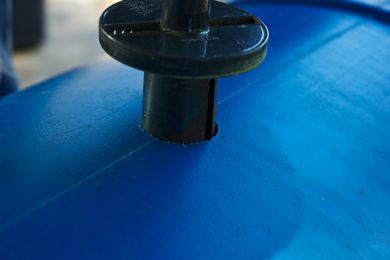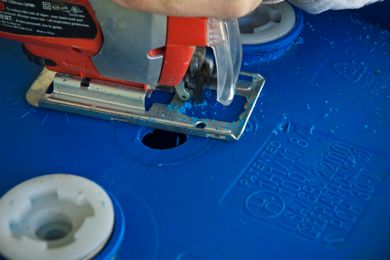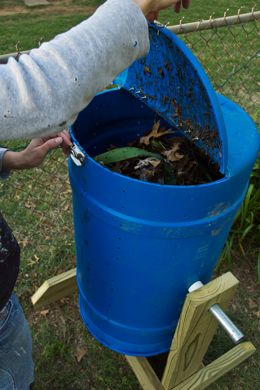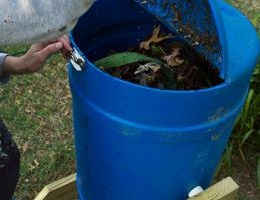DIY Spinning Composter
This year was my first year for a full-fledged garden. I consider it full-fledged because it produced enough to not only feed Biceps and I, but it also allowed me to dehydrate, freeze and give-away the excess.
To be honest, I was just happy that anything sprouted from the earth.
I give props to the composted kitchen and yard waste that we added to the soil-this garden seemed to outperform many of my neighbors’ gardens.
And just in case you don’t want to go spend your hard earned dollars buying a fancy composter in excess of $100 bucks or more, I thought I would show you how to make your own using some recycled and some store bought materials for about $30 in a matter of hours.
(Here’s my video for my DIY Spinning Composter.)

Here’s what you’ll need for your very own composter (The store bought materials can all be found at Lowe’s):
Food Safe Barrel of some sort (I used a leftover crazy person’s 40ish gallon Y2K water barrel they had in their basement in preparation for the end of the world)
3″ ABS toilet flange (I used an Oatey brand for $3.60)
3″ PVC pipe (I bought a 10′ stick-that’s the smallest they had for $10)
3″ PVC cap ($.72)
(2) 2 x 6 x 10 pressure treated lumber (~10′ for $6.97) and pressure treated wood screws (about 20 or so)
(2) hinges with appropriate sized bolts and nuts-don’t use the screws in the package that comes with them (Gatehouse brand 3 1/2″ Butt/Mortise hinges for $2.78 each)
(1) window sash latch with appropriate sized bolts and nuts-don’t use the screws in the package that comes with them (Gatehouse brand for $3.59)
(1) galvanized pipe (I re-purposed a closet rod-1″ diameter and about 4′ length, but if you have to buy one, they are about $5-7)
(8) wood screws 1 1/2″ ish (I used leftovers found in my coffee can full of excess screw, but you may spend $.50)

Here are the tools you will need to complete the project:
Square
Skill Saw with wood blade
Drill with 5/16″ drill bit, hole saw slightly bigger than your galvanized pipe/closet rod
Fine grit sandpaper
Chop Saw
Old screen from window
Tins Snips to cut screen
Flat head & Phillips head screwdriver
Hammer
Let’s get started!

Determine which end is up for you and your barrel. On your “up” end, use your skill saw to cut out a lid in a semi-circle shape (half of the entire circle).

This is what the lid will look like when you are done cutting it out. Sand off any burrs.

Pre-drill the holes for the hinges and the latch. Sand off any burrs. Attach the hardware, using the bolts and nuts (bolts on the outside, nuts inside).

Attach the hole saw to your drill and measure halfway down on each side of your barrel, starting on either side of the lid. The holes should be drilled so that the closet rod will run parallel to the lid. Sand off any burrs.

Drill holes for your closet rod to go through. Insert the closet rod to make sure the barrel can be easily turned. If not, increase the diameter of the hole slightly.

On the bottom of your barrel, trace the 3″ opening for the toilet flange using a sharpee in the center. Cut out the circle with your skill saw and wood blade. Sand off any burrs.

Insert the toilet flange to the outside of the barrel and make sure it fits snugly.

Cut out enough screen to cover the bottom of the opening in the flange. Pre-drill holes in order to screw the flange to the barrel and the screen to the flange.

Remove the closet rod from the barrel and place the PVC pipe vertically in the barrel, fitting it over the toilet flange. Cut the 3″ PVC pipe to fit vertically inside of your barrel, leaving about 6″ headspace between the top of the pipe and the opening of the composter. Place the 3″ cap on top of the pipe.
Mark where the curtain rod will meet with the PVC pipe.

Using your drill with the 5/16″ bit, drill holes several inches apart in the PVC pipe. Using the hole saw, drill two holes in the PVC pipe for the curtain rod to go through.

Using the same 5/16″ drill bit, drill holes vertically in the barrel, about 2″ apart vertically and 6″ apart horizontally.

Cut two identical “legs” for the composter using your chop saw and the pressure treated wood. Begin by measuring from the side of the barrel to center, adding 1 foot to the measurement. For each “leg”, measure 2″ down from one of the cut ends, center the hole saw to cut a circle for the curtain rod to go through.

Cut four identical lengths of wood (mine were about 2′ each in length) to secure the legs to. Attach with the pressure treated wood screws as you see here. I got fancy and cut the corners off of the base pieces. You don’t have to, it doesn’t affect the functionality of the composter.

I added spacers in between the pressure treated wood and the barrel to keep the curtain rod in place. They were just bits of pvc pipe that fit around the curtain rod, cut to about 2″ in length.

Give it a spin and see how much fun making your own compost will be.
Begin collecting all of your kitchen scraps: veggie/fruit peels and scraps, egg shells, coffee filters & grounds, etc (no meat, eggs or dairy) and throw it all in your barrel with dried leaves, grass and yard waste with a ratio of 1 (kitchen waste) to 2 (yard waste). Turn the barrel once a week and keep it as moist as a damp sponge by adding water when needed. (I save old coffee, rinse/rain water, etc. to moisten up the compost).

It’s ready to be used in the garden when the compost smells like heavenly dirt and is black and crumbly. Your plants will thank you so much for this yummy concoction…




















This is awesome! I have been thinking about doing a compost bin but they are expensive. Thanks so much!
jamie@sewrockin.com
Most excellent idea and tutorial. In our new digs with a much smaller yard (30 acres down to a city lot) this composter is exactly the size I need. Good how tos. Thanks.
Thanks for the great tutorial! I am a new follower
Awesome tute! Thanks much.
What a great idea love this! Thanks for sharing.
I’ve always wanted to try composting!
Thanks so much for linking to 2nd Time Around!
This is amazing. I’ve wanted to compost for a long time. Thank you.
I don’t have a lot of leaves, grass, etc. for browns. Instead I use paper from my paper shredder. It makes the compost stick together like a brick though. It requires extra turning but it works!
It’s satisfying using political fliers I don’t agree with as compost
Genius! You know these barrels show up at Goodwill now! Time to pick one up next time for this little DIY!
[…] at Potholes & Pantyhose made this Spinning Composter. I have been trying to plan out a garden in my side yard and I really […]
i love this. i’ve seen it quite a few places. what a great tutorial! i’m a new follower from trendy treehouse!
Hi Rebekah, what a fabulous tutorial. You are so clever. I wish I had this when I had a garden but I don’t think it would be a good idea to have one on my balcony now!!! I found and am now following you through My Romantic Home and will visit often. Please stop by my blog and perhaps you would like to follow me also. Have a wonderful day. Hugs, Chris
you could scale it down!
[…] first experiment was making our very own and very cheap “DIY Spinning Composter”. It took a couple of hours and a couple of bucks, and voila-rich, lovely compost. […]
Thanks for doing this tutorial, the hubbs and I have been searching for different options for making our own and like yours the best. But I was wondering if you could explain the purpose of the pipe down the center. Many of the diy composters (and commercial brands) don’t have this sort of thing in them. I’m thinking it’s to get oxygen in there? But wouldn’t it then drain the juices from the compost that you’d need?
Thanks for your help!
Shaie
The center pipe is for more aeration-to get oxygen to your compost and help speed up the composting process. There are holes-which does allow for some of the juices to drain-but if you have too much in the way of “juices”, it can be detrimental, too. This helps create a nice balance for your mixture-you can always add a little more water (I use leftover coffee typically) if need be.
Few questions, if you don’t mind…
What about the holes in the barrel itself?
How many holes?
Where, on the barrel, do I drill these holes?
thanks for asking that question about the perforated center pipe and end screen. I presumed the correct answer but was fighting the urge to ask while I figured that everyone understood this except me.
[…] DiY Spinning Composter I love getting my hands dirty in the garden. I wanted a composter, but didn’t want to pay […]
[…] wrote a post a few weeks ago outlining how to make a DIY Spinning Composter. I had such a huge response from this particular project, that Biceps and I decided it needed a […]
Thanks for taking the time to put this tutorial together. My husband and I have been discussing composter, but we live in the city and need a composter and then there was the expense. I think something like this will do well for us!
This is really neat. Self-stirring – I like that. Mine are buried into the ground so I have to stir them manually. Bookmarking this. I need to make a few more barrels. Might be nice to have a few different kinds. Thanks!
That was awesome and you are awesome for teaching this to us….
This is exactly what I’ve been looking for!! Awesome instructions Thanks for sharing!!!
Thanks for sharing!!!
[…] topping the list was my DIY Spinning Composter: This horrible picture of me has been repinned on Pinterest over 2K times. I wish I would have had […]
Does this sink. I want to do it but my husband says he doesn’t want something that sinks in our small backyard.
Hasn’t sunk yet! The cross bracing at the base I’m sure prevents that! Are you composting bricks or something?
Why do you ask that? We live in a suburb in Texas. We want to plant a small garden but our soil in central Texas is rocky and has very little top soil. Thought this might help. Just don’t want anything our neighbors could complain about.
I wonder if she meant to ask if this STINKS? lol!! (Why would the neighbors complain if it were to sink?)
@Maggie…I have one and so long as you don’t put meat or dairy or oils in it …no it does not stink.
It will stink, because it’s decomposing/decaying food, but not so bad that neighbors will complain. Also, it is covered, which should contain the smell. My mother in law had a nice, big composter and it was not terribly fun to take the lid off, but as long as the lid is on it should be fine.
This is a great idea! I want to compost but never wanted to spend the money on a spinning composter and really don’t have a place to put a pile in my yard. Thanks for the great tutorial!
Hey Rebekah, put a little bit of dirt into the compost and it will decompose faster, since the dirt already contains a lot of stuff (enzymes) that is what we are trying to achieve right? Just letting you know.
Done and done, Dave. Thanks!
I sooooo want to do this, thank you for the awesome idea. My composter is stuck in one place and hard to get at. This is great.
you are brilliant!!! thank you so much for this.
shelly
This is great…thanks for sharing…I am going to give it a try
Thanks for an excellent tutorial. My neighbor lent me her Cadillac of a composting tumbler a couple of summers ago, and it made the most awesome and fast compost. I’ve been wanting one ever since. I will definitely be trying this!
I’m going to give this a try. Was wondering, how long until I have “usable” compost, if I feed it daily? Do you have to sift out the “usable” compost? Trying to understand how the newer material will mix with the older more decomposed matrial and how it will all be usable and in what time frame, if that makes sense? Thanks for this tutorial!
I “feed” my compost in bulk-saving up my kitchen and yard debris until it’s ready. I keep a mental calendar of when I added what from my kitchen and yard waste. It takes about two weeks or so to break down depending on what I’ve put in there and how hot it is outside. (For example, I have learned to cut up banana peels, crush egg shells and rip up my coffee filters so that they will compost faster). That way, I am emptying out my composter every couple of weeks and starting with a new batch. I may even add a second composter this year so that I can keep things constantly going.
During the winter, I just let the compost sit inside of the barrel the entire season and occasionally add water to it and turn it once a week. I have an entire barrel full for my spring garden! Hope this helps!
It does…I guess I won’t know unless I try!
Well yesterday was an unseasonably warm day for a Mid-March day in Ontario, Canada…. so I decided to put my handy skills to work! I made this spinning composter and it turned out beautifully! So here I am with said composter!
So here I am with said composter!
We even took pictures of our progress – Here is me with the finished product! I <3 my spinning composter! Thanks so much for providing me with everything I needed to get this project done!
My sister suggested I share this photo with you because it was her who found this blog post and shared it with me
http://www.facebook.com/photo.php?fbid=10150720873821760&set=a.10150720800901760.452897.611561759&type=3&theater
Thanks again
This is awesome! I’m so glad that you love it and were able to make one for yourself. Do you mind if I share this photo on my Potholes and Pantyhose Facebook page so that my readers can see another version of the same? Thanks for sending me the link. This made my day!
[…] year, Biceps and I made our DIY Spinning Composter to speed up the process of breaking down organic materials (a couple of weeks instead of a couple […]
Just curious….why the pvc pipe with the holes inside the barrel? I am actually a construction worker so I can get all the supplies for nothing! Hooray! Doing it this weekend!
The holes that are drilled in both the barrel and the PVC pipe aid in air flow throughout the composting process. The compost needs air to decompose. And the PVC through the center of it helps break it down quickly. Let me know if you have any other questions!
[…] my empty DIY Composter is getting a good […]
I have seen a similar one on a website but dould never find it again. Thanks for making the instructions so easy. Also, I have a suggestion. Put a couple more short pieces of plastic pipe at different angles through the center pipe and that will help stir the compost. I want to get started making a couple of these for myself.
[…] you haven’t seen my DIY Spinning Composter already, here she is. (And here’s the video of it in action.) This composter design speeds up […]
[…] me to this point. My vegetables are in the beautiful black earth, soaking up the nutrients from my composter. The gathered rainwater is providing the moisture and my song is providing the incentive to […]
[…] potholesandpantyhose.com via Julie on […]
You are a genius and about to save us some serious money! My husband has this huge barrel and I’m begging him to make this for me. I’ve never kept a compost pile before, so please excuse me if my question is stupid. Can we really use lawn clippings? Because the lawn mower is gas powered and I’m worried about chemicals and contaminants.
I don’t use my own lawn clippings, because our lawn has a few weeds in it. I get my grass clippings from a neighbor who has spent years hand digging out all of his weeds. He doesn’t use fertilizer or spray chemicals on his lawn. He too, uses grass clippings for his small garden but produces too much just for himself. So, he shares them with me! I’ve not seen myself any warnings about gas powered mowers and clippings. But there may be some research worth reading on the subject. I’m assuming it’s just like the rest of nature which filters out our car exhaust, etc. Hope you enjoy your new composter!
I’m curious to hear from pet owners. With the “juices” draining onto the ground, I’m certain my dog would get into it. She will roll around in anything that stinks or lick/try to eat anything that might have been people food. Has anyone else had this problem?
[…] #idea – #DiY Spinning #Composter Make #composting easier. #green Found it here http://www.potholesandpa... Want to express your opinion about topics in the news? Or find out what other people are thinking? […]
How big of a garden would this compost cover? I would love to do something like this but I don’t know if I need more than one or not.
Since the compost breaks down rather quickly, (2-4 weeks due to the rotation process), you can continuously create compost. It’s not a one time shot. As soon as I get the lovely black dirt, I empty and fill again.
I was wondering how much area this compost would cover. I would really like to do something like this but I don’t know if I will need more than one or not.
[…] Spinning Composter is filled to the brim and ready to fertilize my soil-naturally. My Rain Barrels are full and ready […]
I love this design. I am going to be making this and composting for the 1st time. (very excited)
I am wondering about the PVC center pipe do the holes get clogged up? How do you unclog it to keep air flow while waiting for the compost to be ready for use?
Jennifer-
The holes in the PVC are designed to let excess moisture out and are pretty small. I’ve never had an issue with them being clogged up. Air flow is achieved by turning the composter-which shakes things up a bit and allows for internal pockets of air. The holes on the outside of the composter allow for airflow as well. Hope this helps, but if it doesn’t-feel free to email or leave another comment!
Yes, that helped clear things up. Thank you for your fast reply, I appreciate it very much.
I am starting on it tomorrow
Have you had any problems with the area of the barrel where it rests on the pipe? Seems like it could be subjected to a lot of stress under the weight of a full barrel… I’m thinking of building mine with pipe flanges at those spots sandwiching the barrel wall, wondering if you think that’s warranted.
EC-
Great question! I have had my composter filled to the brim for two years-almost straight. (We eat a lot of veggies and have a lot of scraps!). The pipe has been much more than sufficient that the barrel turns on, and the thick food grade plastic has held up wonderfully. But, I’m sure there’s always room for creative improvement. Let me know how it goes!
What’s the purpose of the holes produced from this instruction… “Using the same 5/16″ drill bit, drill holes vertically in the barrel, about 2″ apart vertically and 6″ apart horizontally.”?
V-
This allows for air flow throughout the barrel, which aids in the decomposition of the internal materials. Please, if you have any more questions, let me know!
You are a blessing. This is just what I was searching for.
BUT, my container is white. Will the color be a problem?
Ary-
The one thing to consider is the darker the container, the faster the compost will break down (black absorbs heat while white reflects it). But, if you don’t mind waiting a little longer, the color shouldn’t be an issue as long as it’s a food safe container. That’s the most important thing. You don’t want chemicals leaching into your composter and in turn into your soil. Let me know how it turns out!
You might consider painting the white barrel black with Krylon or other paint that adheres to plastic. The black paint will absorb the heat just as a black plastic barrel would.
Seems awesome… So pumped about I went and bought supplies, but had a hard time finding a barrel… Any recommendations out there? Thank you!
I searched for “plastic barrel” on craigslist in my area and found 2 people selling them. Make sure you ask what was stored in them. Don’t want any nasty chemicals.
I’ve started to build my compost barrel, but ran into a problem. My barrel isn’t keeping it’s shape after cutting off the top, so the latch isn’t working too well.
I know the problem will go away as the barrel is filled up, but does anyone have a solution in the interim to keep the lid closed as I spin the barrel? I know the easy answer is to buy a different latch, but I’d like to do something that doesn’t require me to spend more money.
Thanks!
Sean, I had the same problem with that type of latch so I just used a hook and eye instead and it works great.
I had that concern as well so I used two window latches off center. Still doesn’t close perfect, but it’ll work.
[…] DIY Spinning Composter-speed up the time it takes to compost from a couple of months to a couple of weeks! […]
Looks like a great idea, but there is one step that doesn’t make sense.
“Using the same 5/16″ drill bit, drill holes vertically in the barrel, about 2″ apart vertically and 6″ apart horizontally.”
Drill how many holes? Where? Hundreds of them covering the entire barrel? What are these for, I can’t see them being used at all later? Why do they not show up in any of your subsequent photos?
[…] Source […]
[…] supply catalogues and wondered if they work as well as they allege. When I happened across a design for a homemade compost tumbler, from the blog Potholes and Pantyhose, I recognized a golden […]
I am so grateful for these directions! I built two to replace two other attempts at composting (a manufactured tumbler that I had to assemble; it started cracking at the stress points where the horizontal pipe went through and a manufactured four-walled, open to the ground bin that attracted rats even after I put a finer-grade chicken wire-type barrier beneath). I’ve posted four photos here and will eventually add a current photo, as I made a change to the latches:
https://www.facebook.com/christina.marie.love/media_set?set=a.10201220947271385.1073741832.1402201848&type=3
There were a few things I did differently to achieve the same outcome:
~ used a reciprocating saw to cut the lid while sitting on the barrel to brace it (can’t remember if it was a wood or metal blade but either would probably work)
~ used a boring bit on one drill to start all of the holes on the barrel and PVC and then finished each with the appropriate sized bit because it was too slow and too much effort just using the bigger bit to puncture the thick plastic; an electric drill provided the extra power needed to penetrate the thick plastic and having a couple drills on hand, including two cordless, allowed me to leave the bits I was rotating between at the moment with ease
~first installed the window lash on both bins; then created a different closure method after the first spin of the full one – the window lash failed to do its job, the lid opened while upside down, and 1/5 of the contents spilled out. Instead, I’ve installed on each: 4 thick, long eye bolts (2 on lid, 2 on body of barrel) with a nut sandwiching the walls of the barrel/lid and a shoe lace fed through the 4 of them and tied. It’s keeping the lid closed during spinning and easy on/off.
Thank you again so much for creating these directions and the video!!! You empowered me to make a pleasing solution to my compost dilemma! I borrowed some of the tools, had some, and made multiple trips to home/hardware stores. Haven’t yet tallied up the receipts, but I probably made both for less than $100.
[…] Source […]
[…] Source […]
[…] Source […]
[…] are also a variety of compost bin options, from ready to use to homemade. Since my goal is use what I have on-hand whenever possible, I decided to make my own. I found a […]
[…] was SUPER easy, so check out the ORIGINAL TUTORIAL on the blog Potholes & Pantyhose if your feeling a little […]
[…] https://www.potholesandpantyhose.com/2011/10/diy-spinning-composter/ […]
This is a cool DIY thing!!! I love it!
One thing to think about tho…
Granted it is not necessary, it may be a god idea to use stainless steel hardware(nuts, bolts and washers)….after a time, the hardware will rust, & lose its nice looks, and possibly fail to hold….
If you use stainless steel hardware, that will never be a problem.
Stainless steel hardware is a wee bit more expensive, so kep that in mind.
Again, this is just an idea….it is what I used to make mine.
[…] https://www.potholesandpantyhose.com/2011/10/diy-spinning-composter/ […]
[…] built a nifty little flipping compost bin that I found on a blog called Potholes and Pantyhose (https://www.potholesandpantyhose.com/2011/10/diy-spinning-composter/). Don’t get me wrong, I would love to build a whole system that slowly creates the compost in […]
[…] store If you want quick, easy, and basically free (assuming you have some pallets hanging around) If you want a $30 DIY Spinning Composter If you want a simple 3-Bin Composter If you want the Cadillac 3-Bin chicken friendly composter If […]
[…] was SUPER easy, so check out the ORIGINAL TUTORIAL on the blog Potholes & Pantyhose if your feeling a little […]
I built one today. I added a little something…… Wheels…. Lawnmower wheels. Now I can roll it anywhere I want it. Even the misses can move it…. I love it
Why didn’t I think of this?!
I built my composter today! So exciting! But somehow I missed the step of drilling the holes in the outside of the bin. I’ll have to get that done tomorrow, but now that I know I need more holes I’m wondering how leaky this bin is going to be. My plan was for this bin to sit just outside the back door for compost during winter (it’s a long, snowy walk to my regular compost heap), but will I have a big, smelly mess right there by the door? I’ve already realized I should put some kind of caulk or plumbers putty around the flange. Thanks for the great tutorial!
Thank you or putting this up. Great idea and really clear instructions.
WHAT IS THE PURPOSE OF THE CLOSET FLANGE .THE SCREEN &THE PVC PIPE??
Bill-
The closet flange and screen allow excess liquid to drain from the composter. The PVC pipe on the interior-with the drilled holes-provides multiple ways for aeration, which in turn, creates a quicker composting time. Hope this answers your QUESTIONS!
[…] image via Potholes and Pantyhose […]
[…] via Potholes & Pantyhose […]
Rebekah, thanks so much for posting this. I was researching how to do a vertical barrel and love the way you cut the BOTTOM of the barrel for your access. I wound up making two of them so the wife would never run out of space. Besides, I got two free barrels from work thinking I would need two to make one good composter. The only thing I did a little different was that I used two window latches off center to try and keep a tighter cover. Thanks, Mark
Great post! Have nice day ! duhsg
duhsg
[…] Build this compost tumbler […]
[…] DIY Spinning Composter Photo by Potholes and Pantyhose […]
[…] I have the space, I would love to make this DIY rotating composter. This would give my compost that much-needed aeration. A quick Google search led me to this simpler […]
[…] easy to build and fun to use, this spinning composter will transform food waste into plant food very […]
[…] spinning composter uses a large plastic barrel that is kept off the ground by a wood stand. You can push the barrel […]
[…] spinning composter uses a large plastic barrel that is kept off the ground by a wood stand. You can push the barrel […]
This is wonderful! Self-contained, easy to access, easy to shift the contents, and DIY! I think I have the perfect, unused water barrel in my own garage if I can talk my husband into giving it up. Upcycling rules!